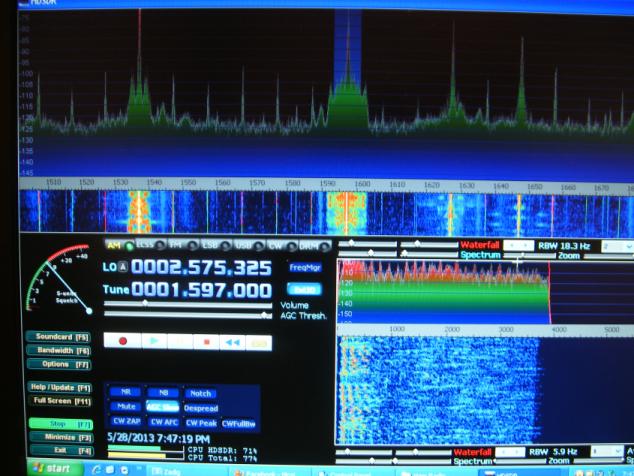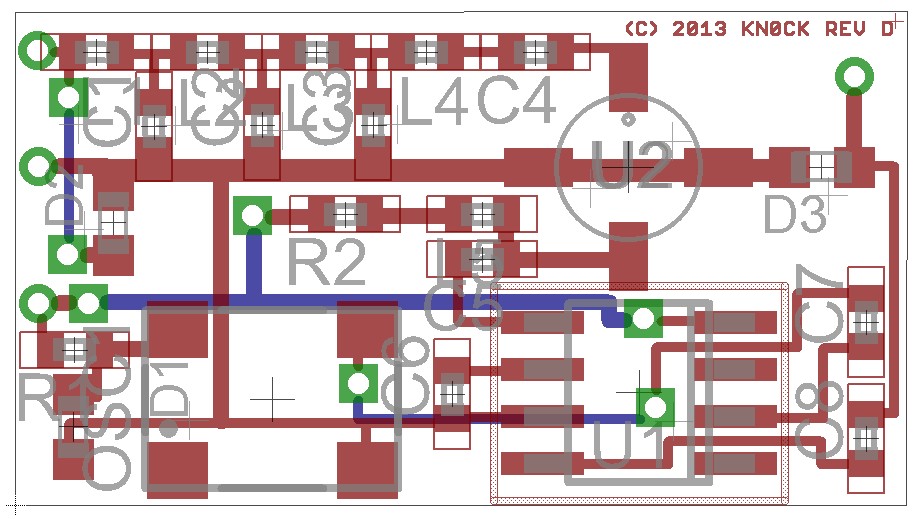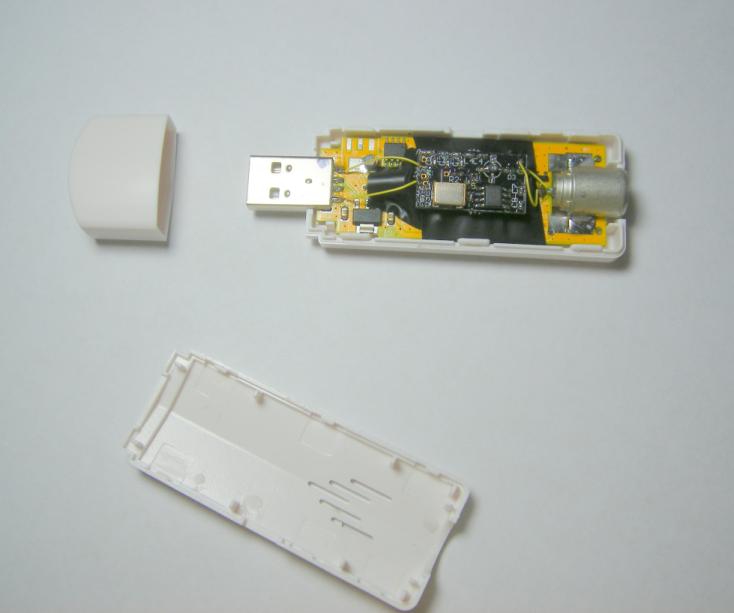BladeRF Units now Shipping
The BladeRF, a transmit capable software defined radio similar to the HackRF is now shipping. BladeRF is a $420 USD SDR designed for hobbyists and RF enthusiasts.

The BladeRF, a transmit capable software defined radio similar to the HackRF is now shipping. BladeRF is a $420 USD SDR designed for hobbyists and RF enthusiasts.

Blogger g0hww shows us how he used his HackRF to decode Pico high altitude balloon (HAB) transmissions using gqrx and dl-fldigi. Pico balloons are small party sized high altitude balloons, typically launched by hobbyists. They have enough lift to carry a small sized ~60g payload. Since they are so small, they are usually exempt from requiring permission from the authorities, unlike full sized weather balloons.
The cheaper RTL-SDR could also be used to track these balloons.
For people already with expensive ham radios, the RTL-SDR can be used as a cheap panadapter. A panadapter is device that allows you to visually see the RF spectrum and waterfall being received by the ham radio. There are multiple (expensive) commercial panadapters available, but combined with a PC or laptop, the RTL-SDR will work just as well.
In this video YouTube user akdude47 shows a tutorial on setting up the RTL-SDR as a panadapter for a Yaesu FT-857. The setup involves connecting the IF output of the radio to the RTL-SDR, and putting in some settings into HDSDR.
In this video YouTube user Roland Zurmely (PY4ZBZ) shows communications with the FO-29 amateur satellite using his RTL-SDR and a 6 element UHF Yagi antenna. The Fuji-OSCAR-29 (FO-29 a.k.a JAS-2) is an amateur radio satellite that allows voice communication via single side band, and has a voice downlink frequency of 435.8 MHz and uplink frequency of 145.9 MHz.
In this video, the RTL-SDR was used as the satellite receiver, and a conventional FT857 radio with 4 element VHF Yagi was used to transmit to the satellite uplink.
Update: KN0CKs products are now available at http://www.kn0ck.com/HF_SDR/.
Yesterday Marty (KN0CK), developer of the miniature integrated HF upconverter for the RTL-SDR that was recently posted wrote into us with some updates.
The version we posted about recently was his “Production 3” version. He writes to tell us that along with his “Production 3” release he created a 15mm x 15mm “Small Form Factor” radio enclosed in one of the smaller RTL2832 tuner dongles, which is the “Worlds Smallest HF Receiver”. Marty writes
This is a non-preamplified model receiver but has EXCELLENT performance for what you get. It has become my most favorite receiver to use here in the shack because of its size and performance – not that I don’t like the preamplified models of my receiver line. I just like how well it performs for such a small receiver – it’s truly unique.
This Small Form Factor Radio has an operating frequency of 100kHz to 54 MHz allowing the 6m band coverage that everyone was so rabid about. The entire design is predicated on using 0402 SMT parts except for what can’t be squeezed down (the crystal oscillator and the SA612 mixer). I have built 6 of these radios and have 3 on hand now for sale now. They retail out at $70.00 because they are HARD to manufacture and are hand-assembled and tested.
If you are interested you can contact Marty at martywittrock_AT_gmail_DOT_com.
Below are some images. The first image shows the size of the worlds smallest HF receiver, the second shows an example of expected HF performance in HDSDR, and the third image shows the upconverter circuit layout.



In addition to creating the worlds smallest HF receiver, KN0CK has also been working on his “Production 4” model, which has the same performance as his “Production 3” model posted earlier, but is capable of being installed into any RTL2832 DVB-T radio.
This model is now released and will be available for sale at easy-kits.com when “Production 3” is sold out.
Marty writes
The latest production I have is termed as ‘Production 4’ and became a hybrid of my ‘Small Form Factor Radio’ and the existing ‘Production 3’ design. I took the best of both worlds and then modified the low pass filter to operate into 6m like I did on the Small Form Factor Radio, too.
[The ability to install into any RTL2832 DVB-T radio] was the reason for this final [Production 4] spin – so it could go into the DVB-T radios that incorporated the goofy through-hole capacitors they used in their power supply design (and also cheaper to sell).
I’ve incorporated this new HF upconverter design into the RTL2832/820T model radios, too, and while the performance of the DVB-T stick is not wonderful, it works pretty well with the HF Upconverter I have designed and installed in it.
I must tell you that the RTL2832/820T model radios are the cheapest out there and have 3 goofy through-hole caps in there that made it impossible to install my ‘Production 3’ model HF Upconverter into that radio….Until Production 4 came along… 🙂
The three images below show the circuit layout, upconverter and RTL-SDR dongle together, and upconverter circuit by itself.



For the future plans of his worlds smallest HF receiver Marty writes
At this time, I’m going to respin my ‘Small Form Factor’ board to solder the crystal oscillator directly on the board like the Production 4 models do (for awhile, I didn’t have a circuit pads for that oscillator and had to hand wire those on the back of the ‘Production 3’ boards. Production 4 cleared that issue and now I’ll clean up the Small Form Factor radio the same way.
Finally, Marty talks about his plans to create a transmit (TX) modification to the dongle. He writes
[I] am working toward a transmit side app for this stick – – target is December to make that happen. I would keep the ‘Production 3’ form factor and then put the TX stuff on the back side of the board.
We look forward to Marty KN0CKs future work, which is likely to be posted about first by KF7LZE, a friend of Marty’s on KF7LZE’s popular blog.
Popular ADS-B decoding software for the RTL-SDR RTL1090 has updated it’s beta version to build 102. This new build has the following improvements
– Decoder improved by brute force 1-bit error correction and brute force DF11 and DF17 override for unknown DFs. This may be tough stuff for slow computers. If your computer slows down considerably return to a previous version please.
– Tabs introduced – List/Table selection moved to Tabs.
– Stats tab added: this brings back the previous status bar info about USB packets per second.
– II/SI tab added. This tab adds the ability to quickly scan the Mode-S interrogator codes around. A “radar1090.txt” file can be added to the rtl1090 folder that holds II/SI code decodings. A sample file is attached. The II/SI collection can be reset by a right mouse click action. The recently seen codes and the last aircraft responding with that code are display in red onwhite.
– Context menu (right mouse click) for text window, “listhold” established by menu selection, revoked by mouse click.
You can download the latest beta from http://rtl1090.com
Update: KN0CKs products are now available at http://www.kn0ck.com/HF_SDR/.
A few months back we posted about Marty Kn0ck’s plans to sell an RTL-SDR dongle with integrated HF upconverter.
This dongle is now for sale at easy-kits.com.
His RTL-SDR + HF upconverter combination is different to the other combinations posted previously, as Marty uses tiny surface mount components to fit the entire HF upconverter within the dongle casing itself. The result is an RTL-SDR that is capable of tuning between 0 and 30 MHz which goes for $100 USD.
YouTube user Superphish has posted a video showing the trick mentioned in this Reddit thread by Anonofish that enables the E4000 tuner to receive a small portion of the broadcast AM band without doing the direct sampling solder mod, or using an upconverter.
It simply involves tuning to a frequency between 3686.6 – 3730 MHz, at which point AM signals start showing up on the spectrum. It isn’t that useful as you can only tune to the very lowest AM stations, but it is still interesting.